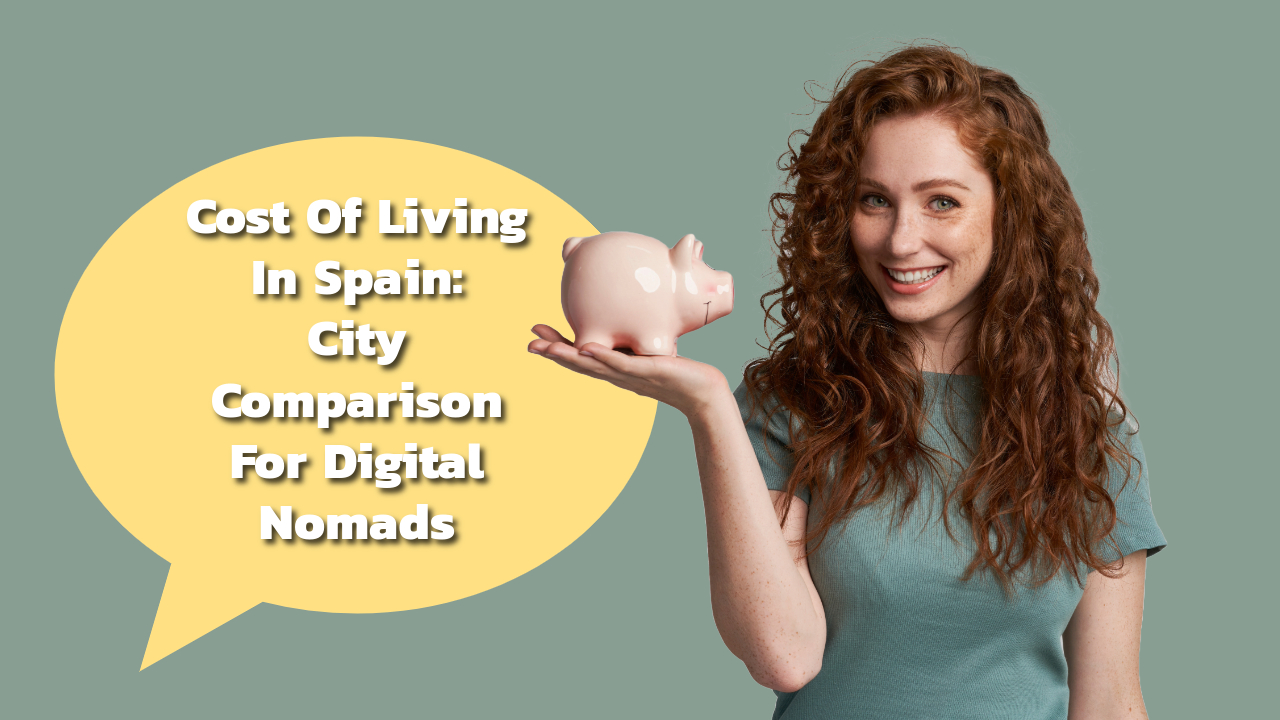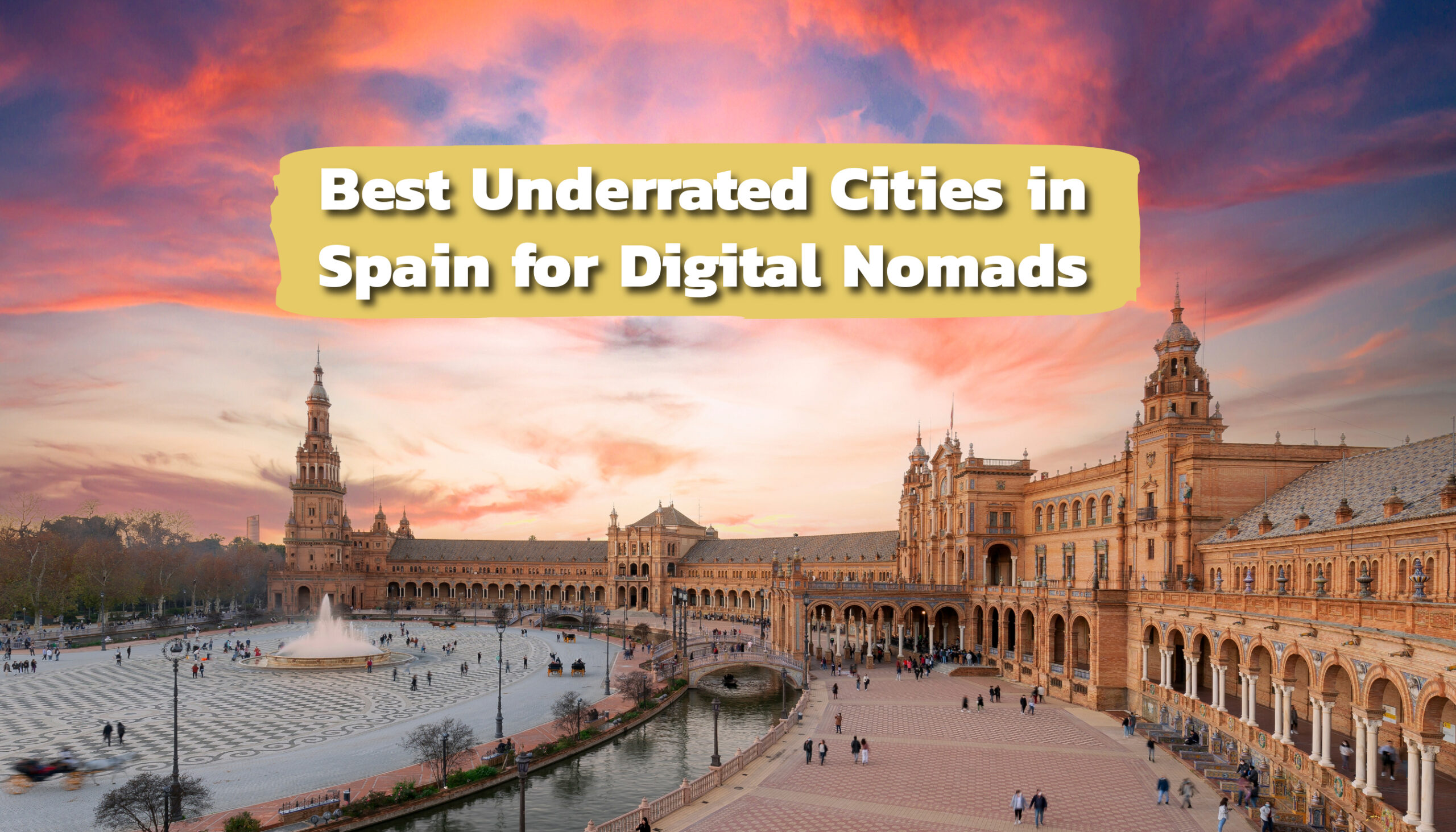Spain has always been a top choice for digital nomads, thanks to its sunny weather, vibrant culture, and laid-back lifestyle. But how much does it actually cost to live here? 💰
In this guide, we’ll take a close look at the cost of living in Spain’s most popular cities. We’ll cover essentials like rent, food, transportation, and more. Whether you’re working with a tight budget or seeking a comfortable yet affordable lifestyle, this post will help you choose the ideal city for your digital nomad adventure. Let’s dive in!
How We Calculated the Cost of Living
When choosing a city as a digital nomad, knowing how much you’ll spend is key. In this guide, we break down the cost of living in Spain’s top cities based on real data from sources like Numbeo, Expat forums, and local rental websites.
To keep things simple, we’ve focused on the most important expenses:
- 🏡 Rent – Prices for a one-bedroom apartment in the city center vs. outside the center.
- 🍽 Food – The average cost of groceries and eating out at restaurants.
- 🚇 Transportation – Public transport costs, taxi fares, and bike rental options.
- 🎉 Entertainment & Extras – Gym memberships, coffee shops, and weekend fun.
💡 Note: In the end, your actual expenses will always depend on your lifestyle. A budget traveler who rents a room in a shared apartment will spend much less than someone renting a private place in the city center.
Now, let’s dive into the numbers and compare the cost of living in Spain’s best digital nomad cities! 🚀
Cost of Living Breakdown by City
Spain offers a variety of cities for digital nomads, each with its own vibe and price tag. Below, we’ll break down the cost of rent, food, transportation, and entertainment in the following top digital nomad destinations:
- Barcelona
- Madrid
- Valencia
- Seville
- Malaga
- Granada
- Bilbao
- Santander
- Gijon
- Oviedo
- Santiago De Compostela
- Las Palmas De Gran Canaria
- Santa Cruz de Tenerife
- Palma De Mallorca
🏙️Barcelona – Lively & Cosmopolitan
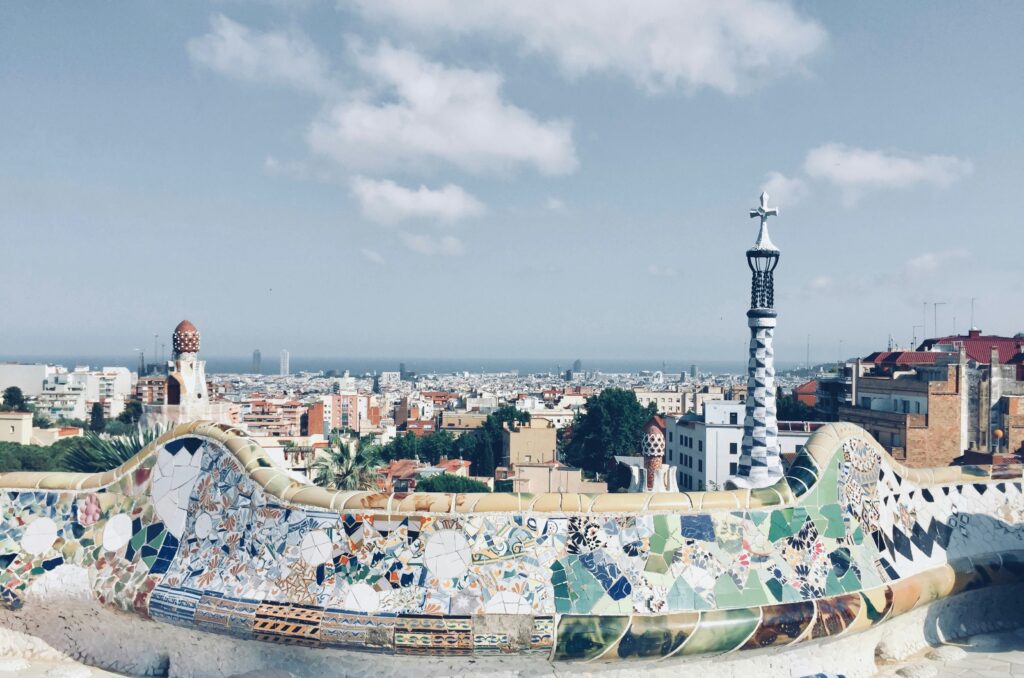
Barcelona is Spain’s most international city, known for its stunning beaches, thriving startup scene, and buzzing nightlife. But it’s also one of the most expensive places to live.
💰 Estimated Monthly Budget: €1,800 – €2,500
- 🏡 Rent: €1,100 – €1,500 (city center) | €800 – €1,100 (outside center)
- 🍽 Food: €250 – €400 (groceries) | €12 – €15 (restaurant meal)
- 🚇 Transportation: €45 (monthly metro/bus pass) | €2.40 (single ticket)
- 🎉 Entertainment & Extras: €200 – €400 (co-working spaces, gym, leisure)
✅ Best for: Digital nomads who love fast-paced city life, networking opportunities, and an international crowd.
❌ Downsides: High rent, tourist crowds, and rising costs.
🏙️ Madrid – A Cultural Capital with a Thriving Remote Scene
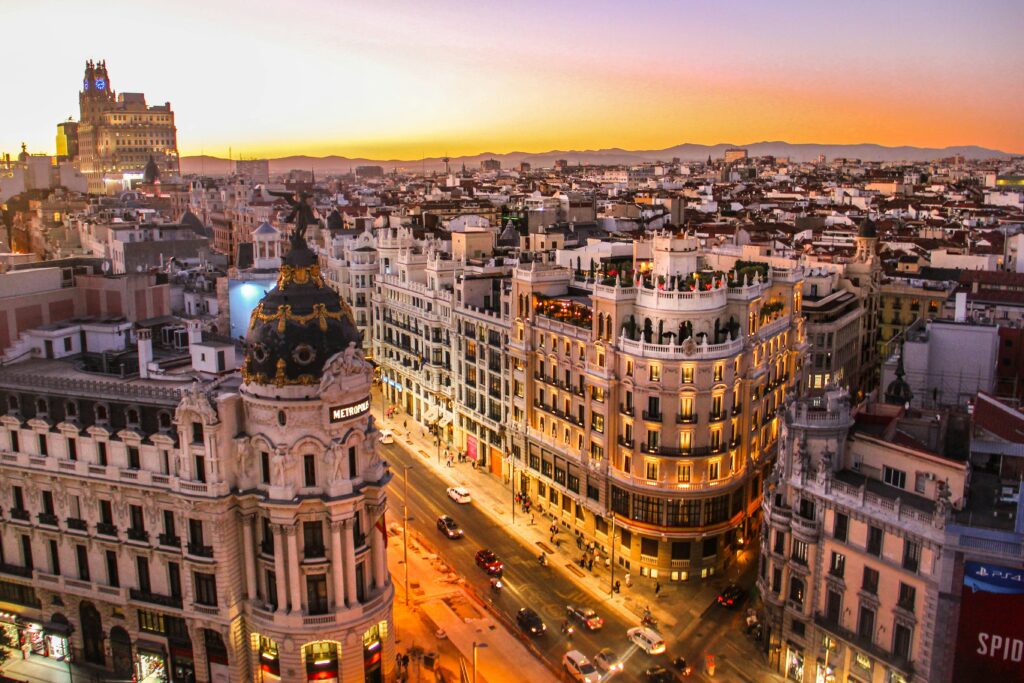
Spain’s capital has a vibrant mix of history, nightlife, and excellent infrastructure. While rent is high in central areas, you can find budget-friendly spots in neighborhoods like Vallecas or Carabanchel.
💰 Estimated Monthly Budget: €1,700 – €2,400
- 🏡 Rent: €1,100 – €1,700 (1-bedroom in city center) | €800 – €1,200 (outside center)
- 🍽 Food: €10 – €14 (restaurant meal) | €250 – €400 (groceries)
- 🚇 Transportation: €55 (monthly public transport pass)
- 🎉 Entertainment & Extras: €150 – €350
✅ Best for: Digital nomads who love big cities, networking, and great food & culture.
❌ Downsides: More expensive than other Spanish cities, traffic congestion.
🌅 Valencia – Affordable, Relaxed & by the Beach
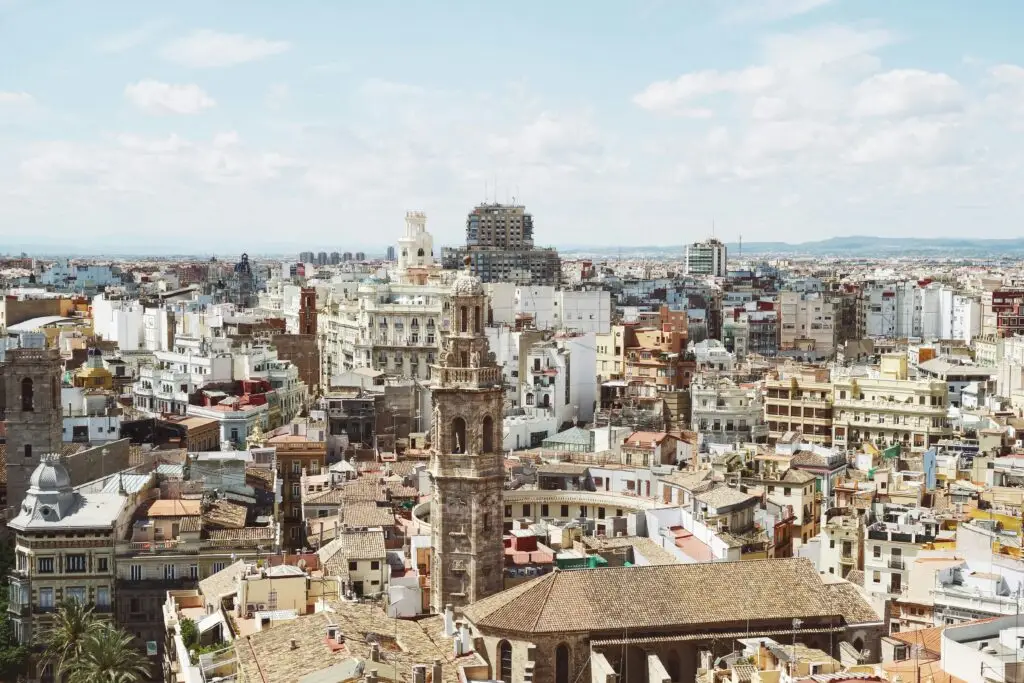
Valencia is a rising star for digital nomads! It’s more affordable than Madrid and Barcelona, with a relaxed atmosphere, beautiful beaches, and a growing remote work community.
💰 Estimated Monthly Budget: €1,300 – €1,800
- 🏡 Rent: €700 – €1,100 (1-bedroom in city center) | €500 – €800 (outside center)
- 🍽 Food: €8 – €12 (restaurant meal) | €200 – €350 (groceries)
- 🚲 Transportation: €40 (monthly metro/bus pass) | €15 (monthly bike rental)
- 🎉 Entertainment & Extras: €100 – €250
✅ Best for: Digital nomads who want a balance of city life, affordability, and a laid-back Mediterranean lifestyle.
❌ Downsides: Not as many international networking opportunities as Madrid or Barcelona.
🌞 Seville – Budget-Friendly & Full of Culture
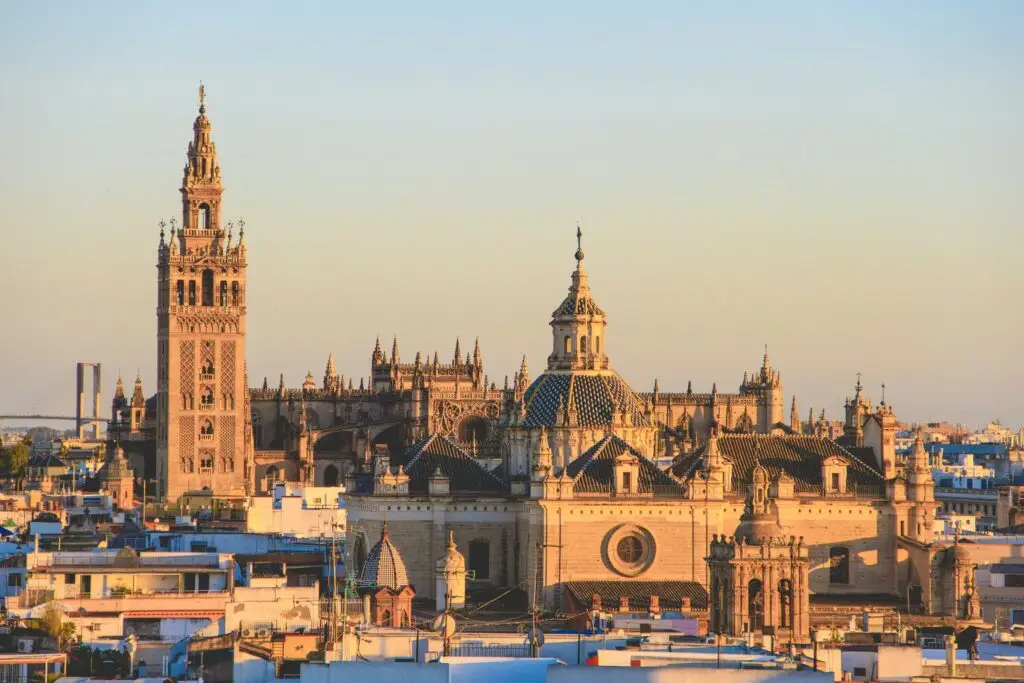
If you’re looking for an authentic Spanish experience with lower living costs, Seville is a fantastic choice. This sunny city in Andalusia is famous for its flamenco, historic architecture, and vibrant culture.
💰 Estimated Monthly Budget: €1,100 – €1,600
- 🏡 Rent: €600 – €1,000 (city center) | €400 – €700 (outside center)
- 🍽 Food: €200 – €350 (groceries) | €10 – €12 (restaurant meal)
- 🚋 Transportation: €35 (monthly bus pass) | Walking is very common!
- 🎭 Entertainment & Extras: €100 – €300
✅ Best for: Budget-conscious nomads who love culture, history, and warm weather.
❌ Downsides: Very hot summers, not as many job opportunities as Madrid or Barcelona.
🌅Málaga – Sunshine, Beaches & Great for Networking
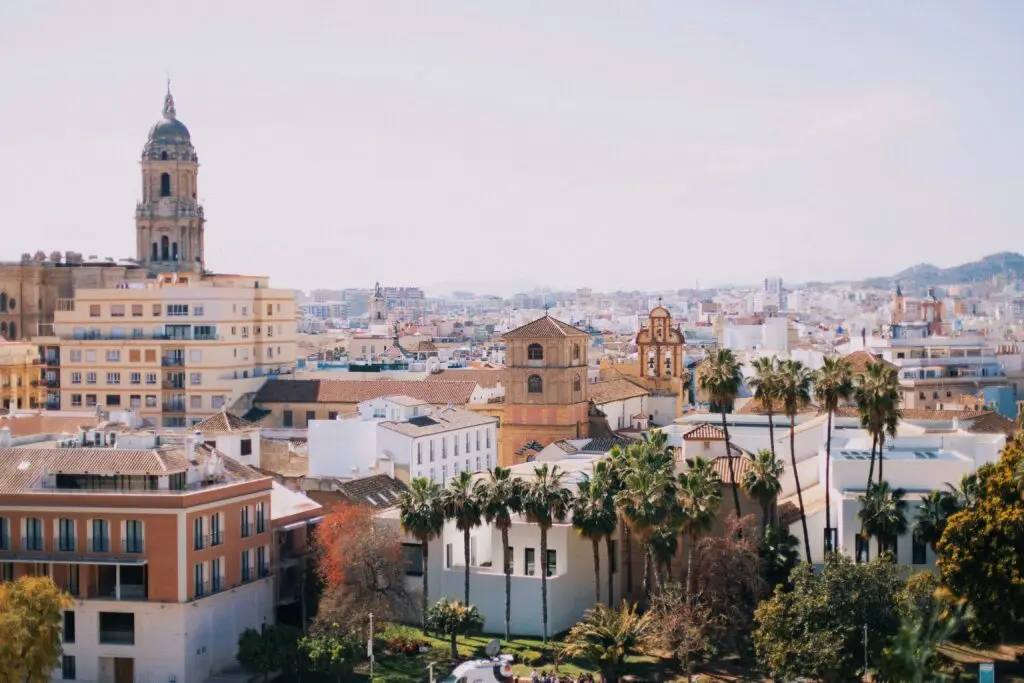
Málaga is one of Spain’s top digital nomad hotspots, thanks to its year-round warm weather, beachside location, and growing coworking scene. It’s more affordable than Madrid and Barcelona but still offers a lively atmosphere.
💰 Estimated Monthly Budget: €1,300 – €1,900
- 🏡 Rent: €800 – €1,200 (city center) | €600 – €900 (outside center)
- 🍽 Food: €8 – €12 (restaurant meal) | €200 – €350 (groceries)
- 🚍 Transportation: €40 (monthly bus pass)
- 🎉 Entertainment & Extras: €150 – €300
✅ Best for: Beach lovers, remote workers who want warm weather all year.
❌ Downsides: Tourist-heavy, especially in summer.
🌄 Granada – A Hidden Gem with Free Tapas
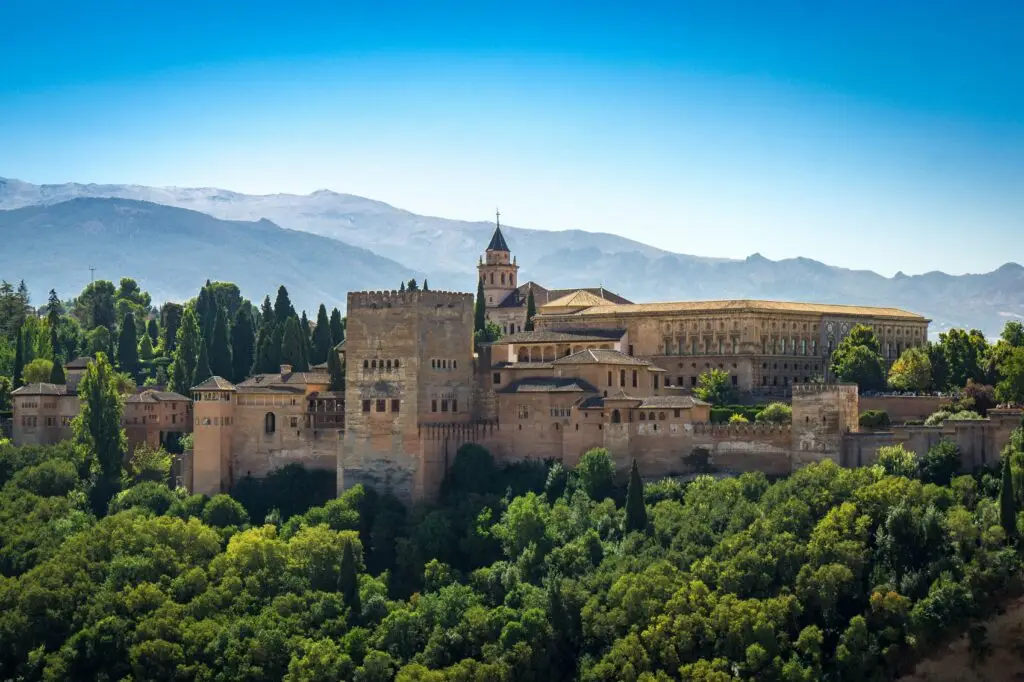
Granada offers stunning mountain views, rich history, and one of the best perks in Spain—free tapas with every drink! The cost of living here is very low, making it perfect for budget-conscious digital nomads.
💰 Estimated Monthly Budget: €1,000 – €1,500
- 🏡 Rent: €500 – €900 (city center) | €400 – €700 (outside center)
- 🍽 Food: €6 – €10 (restaurant meal) | €180 – €300 (groceries)
- 🚋 Transportation: €35 (monthly bus pass) | Very walkable city
- 🎭 Entertainment & Extras: €100 – €250
✅ Best for: Budget nomads, lovers of history, and foodies.
❌ Downsides: Smaller remote work community, can get cold in winter.
🏙️ Bilbao – A Modern, Green & Foodie-Friendly City
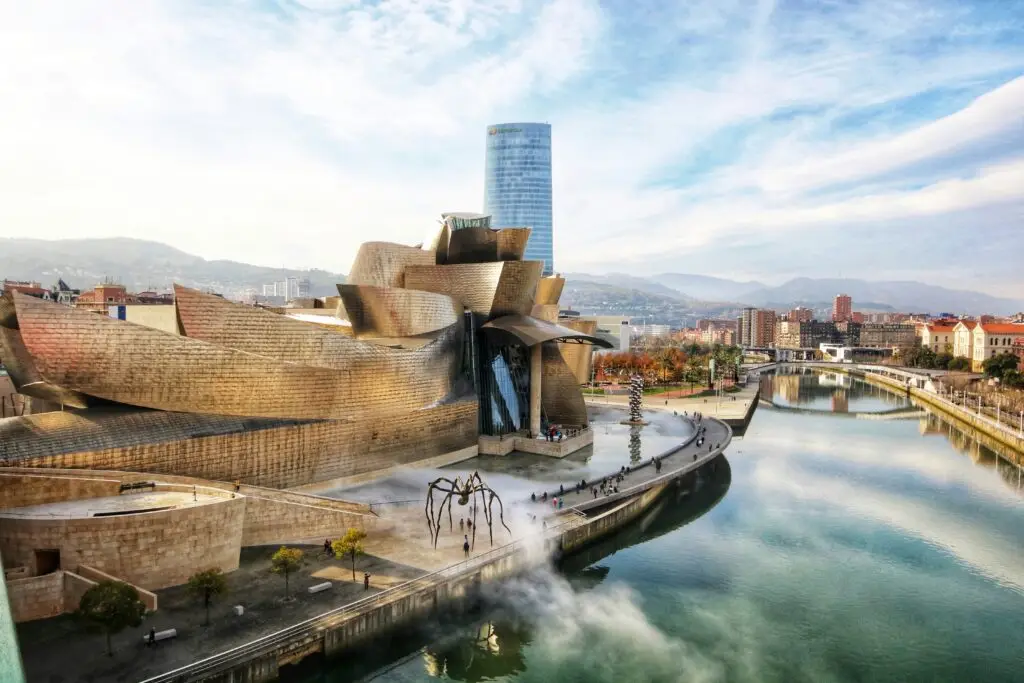
Located in the Basque Country, Bilbao is famous for its modern architecture, greenery, and top-notch cuisine. It’s more expensive than some Spanish cities but offers a high quality of life.
💰 Estimated Monthly Budget: €1,400 – €2,000
- 🏡 Rent: €900 – €1,400 (city center) | €700 – €1,100 (outside center)
- 🍽 Food: €12 – €18 (restaurant meal) | €250 – €400 (groceries)
- 🚇 Transportation: €50 (monthly metro/bus pass)
- 🎉 Entertainment & Extras: €150 – €300
✅ Best for: Digital nomads who love good food, culture, and green spaces.
❌ Downsides: Rainy weather, higher cost of living.
🌊 Santander – A Coastal Retreat with a Relaxed Vibe
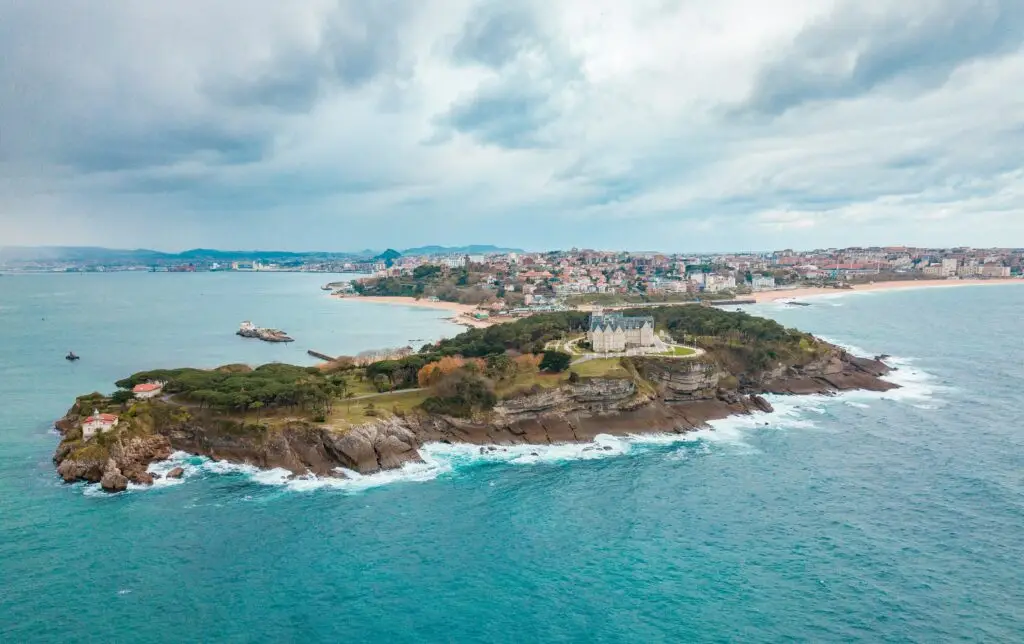
Santander is a small but beautiful city on Spain’s northern coast. With its stunning beaches, fresh seafood, and relaxed pace, it’s a great escape from busier cities.
💰 Estimated Monthly Budget: €1,200 – €1,700
- 🏡 Rent: €700 – €1,100 (city center) | €500 – €900 (outside center)
- 🍽 Food: €10 – €14 (restaurant meal) | €200 – €350 (groceries)
- 🚍 Transportation: €40 (monthly bus pass)
- 🎉 Entertainment & Extras: €100 – €250
✅ Best for: Nomads who love quiet coastal towns and nature.
❌ Downsides: Fewer coworking spaces, rainy weather.
🌊 Gijón – A Budget-Friendly Seaside City
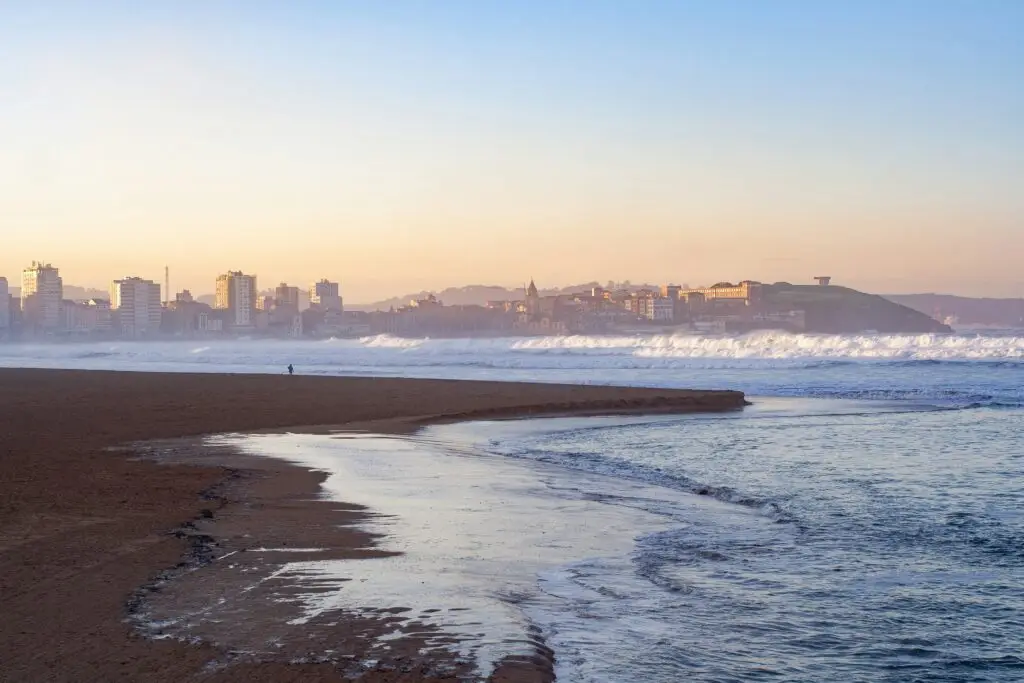
Gijón is a hidden gem in Asturias that offers an affordable cost of living, beautiful beaches, and a lively local scene. It’s perfect for those who prefer authentic Spanish culture over tourist hotspots.
💰 Estimated Monthly Budget: €1,100 – €1,600
- 🏡 Rent: €600 – €1,000 (city center) | €450 – €800 (outside center)
- 🍽 Food: €8 – €12 (restaurant meal) | €200 – €300 (groceries)
- 🚍 Transportation: €35 (monthly bus pass)
- 🎉 Entertainment & Extras: €100 – €200
✅ Best for: Nomads looking for an affordable coastal city with great food.
❌ Downsides: Smaller international community.
🌄Oviedo – History, Culture & Affordable Living
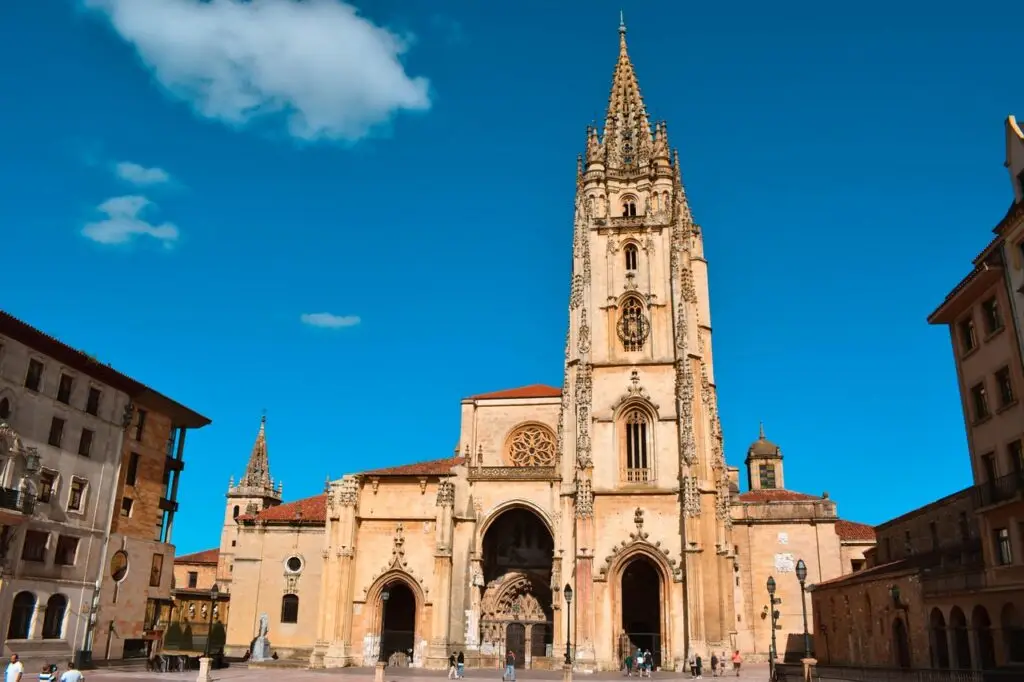
Oviedo, Asturias’ capital, is known for its charming streets, cider culture, and low cost of living. It’s a great option for digital nomads who want an affordable but well-connected Spanish city.
💰 Estimated Monthly Budget: €1,000 – €1,500
- 🏡 Rent: €500 – €900 (city center) | €400 – €700 (outside center)
- 🍽 Food: €8 – €12 (restaurant meal) | €200 – €300 (groceries)
- 🚍 Transportation: €30 (monthly bus pass)
- 🎉 Entertainment & Extras: €100 – €200
✅ Best for: Budget-conscious nomads who love history and good food.
❌ Downsides: Less international diversity.
⛪ Santiago de Compostela – A Tranquil, Spiritual Escape
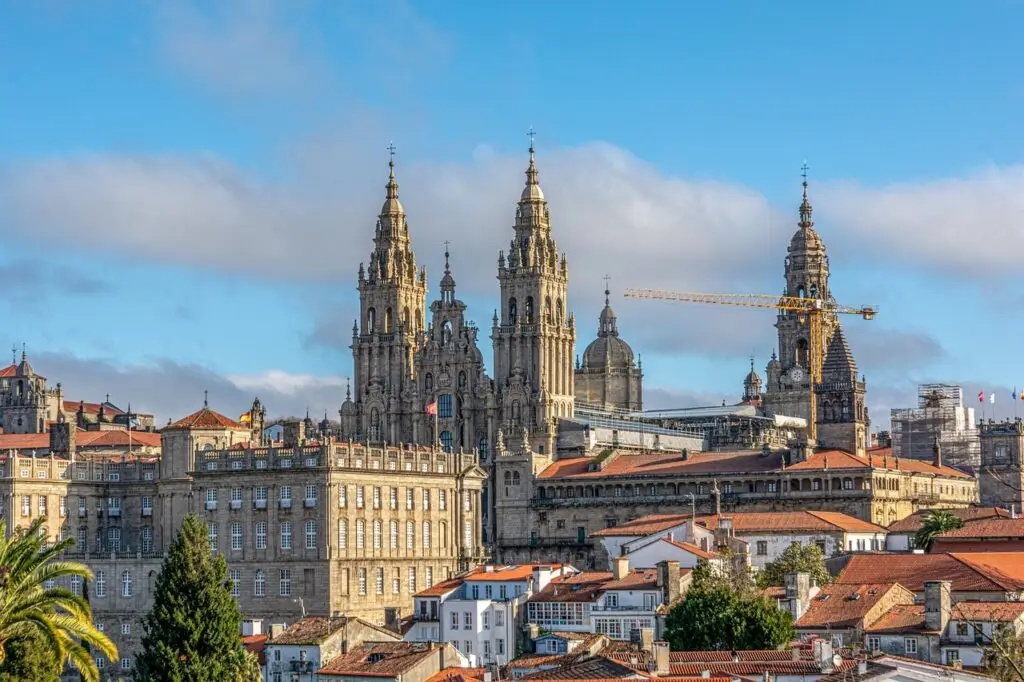
Famous for the Camino de Santiago pilgrimage, this city in Galicia is a peaceful and affordable place for digital nomads who enjoy a laid-back lifestyle with a strong cultural identity.
💰 Estimated Monthly Budget: €1,000 – €1,400
- 🏡 Rent: €500 – €800 (city center) | €400 – €600 (outside center)
- 🍽 Food: €7 – €10 (restaurant meal) | €180 – €300 (groceries)
- 🚍 Transportation: €30 (monthly bus pass)
- 🎉 Entertainment & Extras: €80 – €200
✅ Best for: Peaceful living, nature lovers, history buffs.
❌ Downsides: Fewer coworking spaces, rainy weather.
🌴 Las Palmas de Gran Canaria – A Paradise for Remote Workers
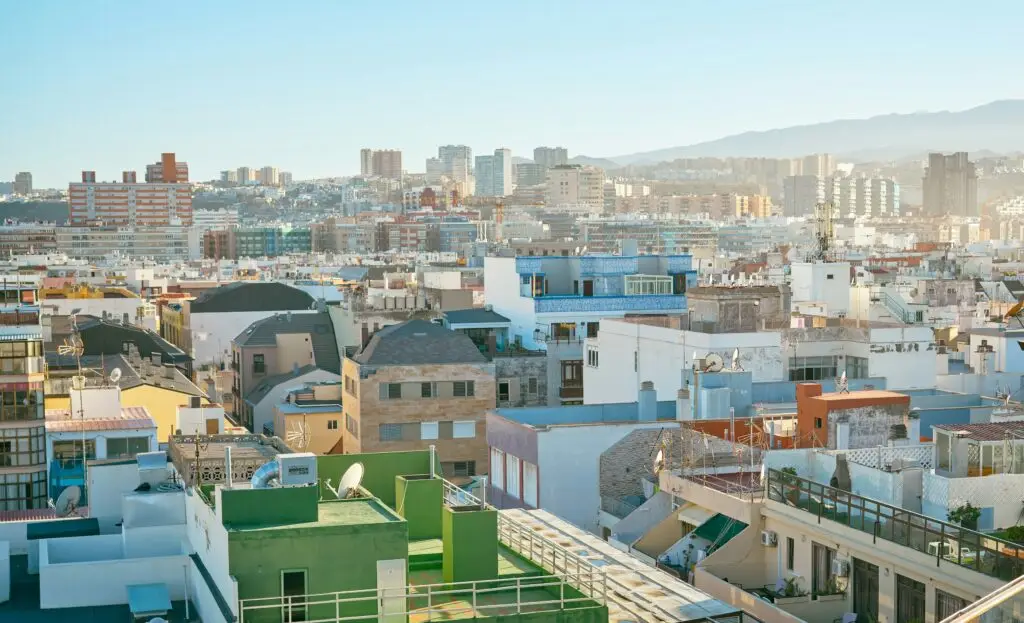
One of the best digital nomad hubs in Spain, Las Palmas offers year-round sunshine, fast internet, and a strong nomad community.
💰 Estimated Monthly Budget: €1,300 – €1,900
- 🏡 Rent: €700 – €1,200 (city center) | €500 – €900 (outside center)
- 🍽 Food: €8 – €12 (restaurant meal) | €200 – €350 (groceries)
- 🚍 Transportation: €40 (monthly bus pass)
- 🎉 Entertainment & Extras: €150 – €300
✅ Best for: Nomads who love warm weather, beaches, and community events.
❌ Downsides: Can be touristy.
🌴 Santa Cruz de Tenerife – Island Life with Low Costs
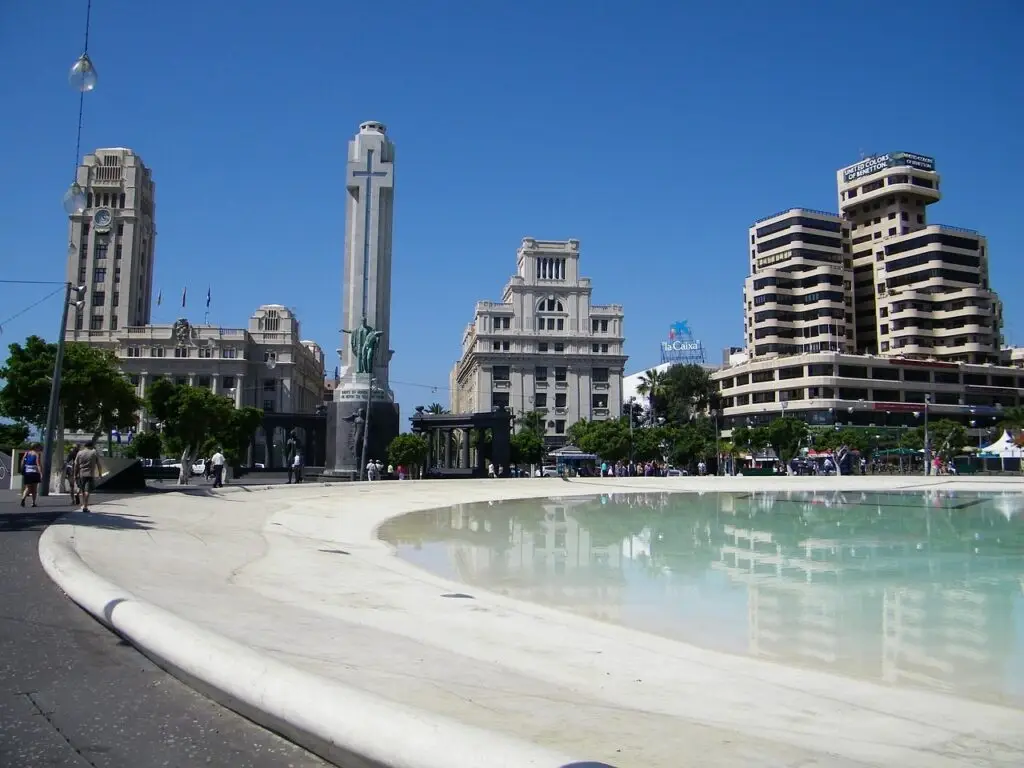
Santa Cruz de Tenerife offers the best of both worlds: island paradise vibes combined with all the conveniences of a capital city. It’s warm year-round, making it a great spot for digital nomads who love the outdoors, hiking, and surfing.
💰 Estimated Monthly Budget: €1,200 – €1,800
- 🏡 Rent: €600 – €1,100 (city center) | €500 – €900 (outside center)
- 🍽 Food: €8 – €12 (restaurant meal) | €200 – €350 (groceries)
- 🚍 Transportation: €38 (monthly tram/bus pass) | Affordable taxis & rental scooters
- 🎉 Entertainment & Extras: €120 – €300
✅ Best for: Nature lovers, those who want an affordable island lifestyle.
❌ Downsides: Can feel isolated, limited coworking options.
🌴 Palma de Mallorca – Beautiful but Expensive
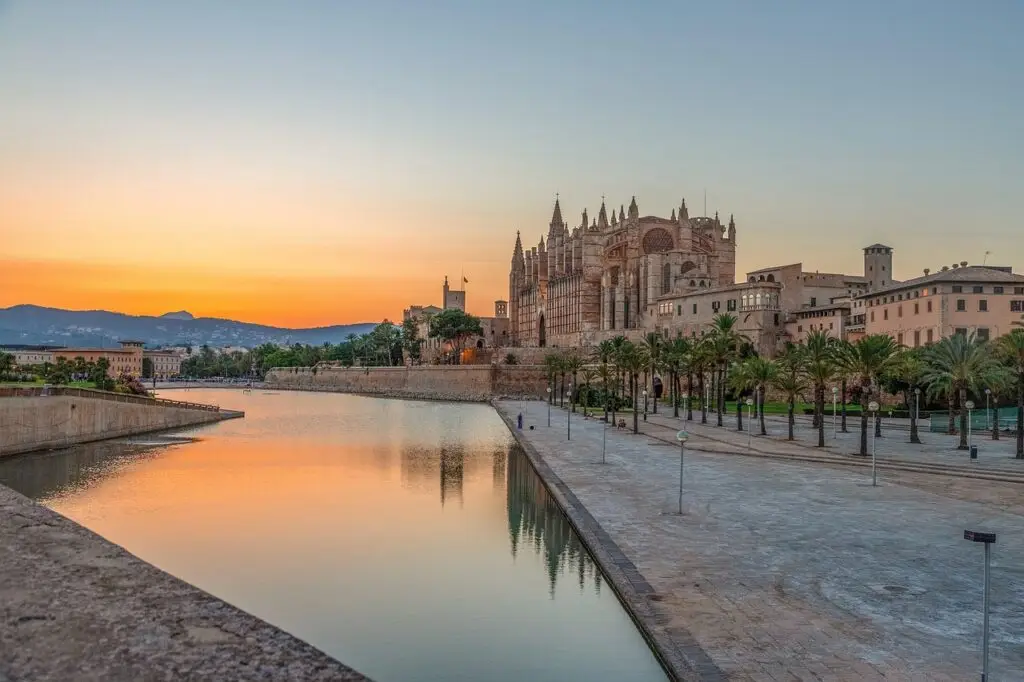
Palma de Mallorca is a stunning island city with a fantastic balance of culture, beaches, and vibrant nightlife. While it’s one of the most expensive cities in Spain, many digital nomads find the coastal lifestyle, historic charm, and great weather worth it.
💰 Estimated Monthly Budget: €1,700 – €2,500
- 🏡 Rent: €1,100 – €1,800 (city center) | €850 – €1,400 (outside center)
- 🍽 Food: €12 – €18 (restaurant meal) | €300 – €450 (groceries)
- 🏍 Transportation: €42 (monthly bus pass) | €1.50 (single ticket) | Scooters & bikes are popular
- 🎉 Entertainment & Extras: €200 – €400
✅ Best for: Digital nomads who want a Mediterranean island lifestyle with a mix of city life.
❌ Downsides: High rent, expensive compared to other Spanish islands.
Summary Table: Estimated Monthly Cost of Living for Digital Nomads in Spain
Now that you’ve seen the cost breakdown for each city, here’s a summary table that allows you to quickly compare the overall living costs across all the cities. This will help you assess which location best fits your budget as a digital nomad in Spain.
| City | Total Estimated Monthly Cost | Rent (1-Bedroom, City Center) | Food (Monthly Groceries) | Public Transport (Monthly Pass) | Utilities + Dining Out + Health Insurance |
|---|---|---|---|---|---|
| Granada | €1,000–€1,400 | €400–€900 | €150–€250 | €30–€45 | €80–€200 |
| Oviedo | €1,100–€1,400 | €500–€900 | €150–€250 | €30–€45 | €80–€200 |
| Santiago de Compostela | €1,100–€1,400 | €500–€900 | €150–€250 | €30–€45 | €80–€200 |
| Gijón | €1,200–€1,750 | €600–€1,000 | €150–€250 | €30–€45 | €90–€200 |
| Las Palmas de Gran Canaria | €1,300–€1,800 | €700–€1,200 | €150–€250 | €35–€50 | €100–€200 |
| Santa Cruz de Tenerife | €1,300–€1,800 | €700–€1,200 | €150–€250 | €35–€50 | €100–€200 |
| Santander | €1,200–€1,750 | €600–€1,100 | €150–€250 | €30–€45 | €90–€200 |
| Málaga | €1,300–€1,800 | €700–€1,200 | €150–€250 | €35–€50 | €100–€200 |
| Bilbao | €1,400–€1,750 | €700–€1,100 | €150–€250 | €35–€50 | €100–€200 |
| Valencia | €1,400–€1,800 | €700–€1,200 | €150–€250 | €30–€45 | €100–€200 |
| Madrid | €1,800–€2,750 | €1,000–€2,000 | €200–€300 | €50–€60 | €130–€300 |
| Barcelona | €2,000–€2,900 | €1,200–€2,000 | €200–€300 | €50–€60 | €130–€300 |
| Palma de Mallorca | €2,300–€3,100 | €1,700–€2,500 | €200–€300 | €45–€60 | €120–€300 |
Which City is Best for Your Budget?

Spain offers digital nomads an amazing quality of life at a variety of price points. Whether you’re looking for an ultra-low-cost city or affordable luxury, there’s an option for every budget. Let’s break it down:
💸 Best for Budget Nomads (Under €1,500/Month)
If you want to live well while spending as little as possible, these cities offer low rent, cheap food, and affordable entertainment:
- Granada – Rent is low (€400–€900/month), and you get free tapas with every drink, making it a paradise for budget-conscious foodies.
- Oviedo – A peaceful, walkable city in Asturias with low rent (€500–€900) and affordable living costs.
- Santiago de Compostela – Low costs (€1,000–€1,400/month) and a slow-paced, historic charm.
- Gijón – A coastal city that’s much cheaper than Barcelona or Valencia, while still offering beach life (€600–€1,000 rent).
✅ Best for: Nomads who want the most affordable cost of living in Spain, with access to culture, great food, and a relaxed lifestyle.
🌊 Best for Affordable Beach Life (€1,400–€1,800/Month)
Dreaming of a sea view but still watching your budget? These coastal cities balance affordability and quality of life:
- Las Palmas de Gran Canaria – Popular for remote workers, with beachfront apartments from €700/month, strong digital nomad communities, and fast WiFi.
- Santa Cruz de Tenerife – Even cheaper than Las Palmas, with rental prices starting at €500/month and a relaxed island atmosphere.
- Gijón – A more affordable alternative to Barcelona, with rent from €450/month and an authentic Spanish vibe.
- Santander – A charming seaside town with lower rent than many coastal cities and excellent seafood.
✅ Best for: Digital nomads who want an ocean view without the sky-high prices of Barcelona or Palma.
🏙️ Best for Big City Life Without Breaking the Bank (€1,500–€2,000/Month)
For those who love the energy of a big city but still want to manage costs, these cities are great options:
- Málaga – Warm weather, beautiful beaches, and a digital nomad hub, all at a reasonable price (€700–€1,200 rent).
- Bilbao – A cosmopolitan city with cheaper rent than Madrid or Barcelona (€700–€1,100 rent), plus an amazing culinary scene.
- Valencia – Spain’s rising star for digital nomads, with affordable housing (€700–€1,200 rent) and a growing expat scene.
✅ Best for: Nomads who want city life with great public transport, culture, and affordability.
💎 Best for Luxury Living & High-End Beach Life (€1,800–€2,500+/Month)
If budget isn’t your biggest concern and you want top-tier city comforts, luxury rentals, and high-end restaurants, check out:
- Madrid – Spain’s most expensive city, but with a world-class cultural scene and endless workspaces. Rent: €1,000–€2,000+.
- Barcelona – A favorite among remote workers, but rents are high (€1,200–€2,000) compared to most Spanish cities.
- Palma de Mallorca – A stunning island destination with higher living costs (€1,700–€2,500) but an incredible lifestyle.
✅ Best for: Nomads who don’t mind spending more for top-tier food, culture, and city life.
❌ Downsides: Higher rent, more expensive dining, and crowded tourist seasons.
No matter what your budget is, you can find a Spanish city that fits your lifestyle. Now, let’s talk about how to save even more money as a digital nomad in Spain!
How to Save Money as a Digital Nomad in Spain 💸
Even though Spain offers affordable options for digital nomads, it’s always nice to save a bit more where you can! Here are some practical tips to help you stretch your budget further while living the dream as a digital nomad in Spain:
1. Rent Smart: Consider Co-Living Spaces
Rent can be one of the biggest expenses, especially in pricier cities. Consider co-living spaces or shared apartments to save money. These not only provide affordable rent (sometimes as low as €300–€600/month for a room) but also include utilities, Wi-Fi, and cleaning services. Plus, you get to meet other digital nomads and share experiences!
💡 Pro Tip: If you’re traveling on a budget, living a bit outside the city center will save you a lot on rent while still giving you easy access to the city’s amenities.
2. Embrace Public Transport & Walk More
Cities like Madrid, Barcelona, and Valencia have excellent public transport systems, so skip the taxis and Uber. A monthly metro/bus pass typically costs between €30–€60. Spain is also super walkable, and exploring on foot will not only save money but also allow you to experience the city in a more authentic way!
💡 Pro Tip: In smaller cities like Granada or Oviedo, you can often walk or bike everywhere, making transportation costs nearly negligible.
3. Cook Like a Local 🥘
Eating out can be tempting, especially with Spain’s amazing tapas culture. However, cooking at home can save you a lot of money. Local markets in cities like Málaga and Granada offer fresh produce at unbeatable prices, and you can easily prepare meals for €2–€4 per dish.
💡 Pro Tip: Take advantage of weekly markets for fresh veggies, meats, and fish. These markets often have cheaper prices than grocery stores.
4. Find Free or Low-Cost Activities
Spain has an abundance of free or low-cost activities for digital nomads to enjoy:
- Free walking tours are available in many cities, like Madrid and Barcelona.
- Beaches in coastal cities like Málaga, Las Palmas, and Valencia are always free.
- Enjoy the Outdoors completely for free.
- Explore the free parks and museums or local festivals to experience the culture without spending a dime.
💡 Pro Tip: Many cities in Spain offer discounted or free museum days once a month (usually on Sundays), so plan to visit those on those days to save some cash! Also check local facebook groups for free community-organized activities like outdoor sports classes and more.
5. Take Advantage of Free Coworking Spaces
If you’re working remotely and need a good place to focus, Spain has many coworking spaces that offer free trials or membership discounts for nomads. In addition to that, cafes in most cities offer free Wi-Fi, and they’re often quieter during the mornings.
💡 Pro Tip: Look for cafes with great Wi-Fi (there are apps for that!), and check out coworking spaces that offer flexible pricing plans depending on how many hours a week you need. Some even offer event meetups or weekly happy hours for networking and socializing!
6. Shop Smart with Local Discounts
Did you know many stores offer discounts for students or digital nomads? Make sure to always ask about discount programs or sign up for loyalty cards at your local grocery store. Many cities also have discount days for clothing and electronics, so you can stock up on what you need without breaking the bank.
💡 Pro Tip: If you’re staying in a city for a longer period, consider buying secondhand furniture or electronics on local marketplace apps like Wallapop for great deals.
7. Work Abroad Programs & Tax Savings
Depending on your nationality and the length of your stay in Spain, you may be able to benefit from tax exemptions for digital nomads under Spain’s non-lucrative visa or other freelancer programs designed to attract remote workers.
💡 Pro Tip: Look into Spain’s Startup Visa if you’re an entrepreneur, or check if your country has a double taxation agreement with Spain. This could help reduce your overall tax bill and save you money while living abroad.
In Conclusion: Enjoy Life in Spain Without Breaking the Bank
Living in Spain as a digital nomad offers a perfect balance of affordable living and high quality of life. Whether you’re living on a shoestring budget in Granada or enjoying a slightly higher-end lifestyle in Palma de Mallorca, Spain has something for every digital nomad.
By embracing local customs, taking advantage of free activities, and using some budget hacks, you can live comfortably and enjoy the beautiful Spanish lifestyle without breaking the bank!
Happy travels and good luck with your Spanish adventure! 🇪🇸💻✨
What’s Your Budget-Friendly Digital Nomad Spot in Spain?
We’d love to hear from you! 💰🌍
- Have you found a cost-effective city to live in Spain?
- Which cities or areas worked best for your budget?
- Any money-saving tips to help fellow digital nomads?
- What strategies or platforms helped you keep costs down?
👉 Questions? Comments? Drop a comment below and share your experience! 👇
Let’s keep the conversation going and help others find the best and most affordable places to live in Spain!
You want to work remotly from Spain but don’t know where to start? Check out our guide 4 Simple Steps to Become a Digital Nomad in Spain! 🚀 Whether you’re just starting out or already soaking up the Spanish sun, this guide will provide you with everything you need to navigate your digital nomad journey in Spain.

